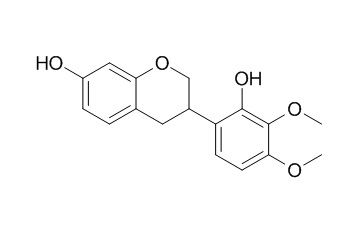Isomucronulatol
Isoliquiritigenin and liquiritigenin exhibit significant inhibitory effects on LPS-induced IL-6 and IL-12 p40 production, with IC 50 values ranging from 2.7 to 6.102uM, isoliquiritigenin also shows a moderate inhibitory effect on LPS-stimulated production of TNF-α with an IC 50 value of 20.102 uM, they have potential anti-inflammatory effects. Isomucronulatol exhibits noticeable ABTS+ scavenging activity, it exhibits moderate inhibition against butyrylcholinesterase.
Inquire / Order:
manager@chemfaces.com
Technical Inquiries:
service@chemfaces.com
Tel:
+86-27-84237783
Fax:
+86-27-84254680
Address:
1 Building, No. 83, CheCheng Rd., Wuhan Economic and Technological Development Zone, Wuhan, Hubei 430056, PRC
Providing storage is as stated on the product vial and the vial is kept tightly sealed, the product can be stored for up to
24 months(2-8C).
Wherever possible, you should prepare and use solutions on the same day. However, if you need to make up stock solutions in advance, we recommend that you store the solution as aliquots in tightly sealed vials at -20C. Generally, these will be useable for up to two weeks. Before use, and prior to opening the vial we recommend that you allow your product to equilibrate to room temperature for at least 1 hour.
Need more advice on solubility, usage and handling? Please email to: service@chemfaces.com
The packaging of the product may have turned upside down during transportation, resulting in the natural compounds adhering to the neck or cap of the vial. take the vial out of its packaging and gently shake to let the compounds fall to the bottom of the vial. for liquid products, centrifuge at 200-500 RPM to gather the liquid at the bottom of the vial. try to avoid loss or contamination during handling.
J Sci Food Agric.2017, 97(5):1656-1662
Journal of Food Engineering2024, 379:112136.
Chem Res Toxicol.2023, 36(2):213-229.
J Pharm Biomed Anal2016, 118:183-194
J Pharm Biomed Anal.2023, 234:115570.
Anat Rec (Hoboken).2021, 304(2):323-332.
J Sep Sci.2020, 201901140
J. ISSAAS2023, 29(2):36-51.
Mol Divers.2022, s11030-022-10586-3.
Pharm Biol.2022, 60(1):2040-2048.
Related and Featured Products
Arch. Pharm. Res. 2014, 37(2):186-92.
Flavonoids from Astragalus membranaceus and their inhibitory effects on LPS-stimulated pro-inflammatory cytokine production in bone marrow-derived dendritic cells.[Pubmed:
23771500 ]
Radix Astragali (Astragalus membranaceus) is an important traditional Chinese medicine that is widely used as a tonic to enhance the body's natural defense mechanisms.
METHODS AND RESULTS:
In this phytochemical study, 12 flavonoids, isoliquiritigenin (1), liquiritigenin (2), calycosin (3), calycosin 7-O-β-D-glucoside (4), formononetin (5), formononetin 7-O-β-D-glucoside (6), daidzein (7), daidzein 7-O-β-D-glucoside (8), methylnissolin (9), methylnissolin 3-O-β-D-glucoside (10), Isomucronulatol (11), and Isomucronulatol 7-O-β-D-glucoside (12), were isolated from the roots of A. membranaceus. Their structures were elucidated by comparing spectroscopic data with reported values. The effects of the isolated compounds on lipopolysaccharide (LPS)-stimulated bone marrow-derived dendritic cells were investigated.
CONCLUSIONS:
Compounds 1 and 2 exhibited significant inhibitory effects on LPS-induced IL-6 and IL-12 p40 production, with IC50 values ranging from 2.7 to 6.1 μM. Compound 1 also showed a moderate inhibitory effect on LPS-stimulated production of TNF-α with an IC50 value of 20.1 μM. Further studies of the potential anti-inflammatory effects and benefits of flavonoids from A. membranaceus are warranted.
Food Chem. 2011, 126(1):31-8.
Antioxidant and anticholinesterase active constituents from Micromeria cilicica by radical-scavenging activity-guided fractionation[Reference:
WebLink]
METHODS AND RESULTS:
From the acetone extract of Micromeria cilicica, two new (1 and 2) and five known (3–7) compounds were obtained through radical-scavenging activity guided isolation.
Structures of the compounds were identified as piperitone 7-O-β-d-glucoside (1), isothymonin 4′-methyl ether (2), sudachitin (3), Isomucronulatol (4), rutin (5), ursolic acid (6) and saccharose (7), based on UV, 1D-and 2D-NMR and mass spectroscopic techniques.
The antioxidant potentials of the extract and the isolated compounds were established by using three radical-scavenging assays, namely, DPPH scavenging, O2- scavenging and ABTS+ scavenging, besides β-carotene bleaching assay. Particularly, the acetone extract showed a strong inhibition of lipid peroxidation by β-carotene bleaching assay, with a result close to that of (+)-catechin.
CONCLUSIONS:
Among the pure compounds, rutin (5) showed the strongest lipid peroxidation inhibition and antiradical activity while both sudachitin (3) and Isomucronulatol (4) exhibited noticeable ABTS+ scavenging activity. The anticholinesterase activity of the compounds (1–7) was also determined. Against acetylcholinesterase, they exhibited weak inhibition while compounds 3, 4 and 6 exhibited moderate inhibition against butyrylcholinesterase.



